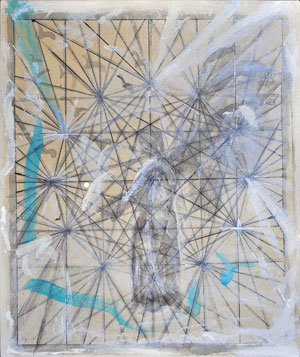Anne Beresford — Ten Thousand Wonderful Things:
A Conversation with the University Collections

Anne Beresford, Your Call; monoprinted lithograph with silver leaf; 17 1/2 x 12"; e.v. 7; 2014
In this exciting new departure, the UMCA invites local artist Anne Beresford to curate a new iteration of our annual exhibition series “Dialogue with a Collection”. Beresford will select and curate material and objects from multiple collections at UMass (art, biology, anthropology, geology, and Special Collections & University Archives) as the basis for an interdisciplinary exhibition. Beresford will seek juxtapositions and alignments, both formal and conceptual, between and among the objects on display, alongside her own artworks which are at the intersection of image and language, the new and the old, the quotidian and the unknowable.
Using classifying methods of science and art, and drawing inspiration from the 17th century concept of the Cabinet of Curiosities, Anne Beresford’s installation celebrates the wonders and rarities common to both natural science and the arts. Organized around categories such as exploration/investigation, artifacts and facts (of man and the natural world), diagrammatic notation and imaginary constructions, the exhibition is a tiny window into the University’s riches.
Running parallel to Ten Thousand Wonderful Things will be an online virtual exhibition created by Art History undergraduate students Rachel Mathison and Jacob Liverman, guided by graduate student Emily Devoe. This simultaneous exhibition will allow virtual visitors access to detailed information about specific objects from the collections, as well as the ability to choose objects and create a unique, user-specific online gallery.
This is an invigorating new direction, not only for the UMCA whose contemporary art exhibitions have involved collaborations with numerous faculty and students from across campus, but also for all the collections at UMass. The UMCA -- the only exhibition space on campus open to the public six days a week, with security and museum standards -- offers a unique opportunity for the public at large to view objects from these collections in a curated situation. This exhibition also offers a showcase for Anne Beresford to present her work, and to take on the role as guest curator in the selection of objects from these collections.
Introductory Text
Every artifact, every object, has a story. What that story means, where it comes from, what we learn from it, what we make of it, is the stuff of science, and the stuff of art. In artwork the stories are fabricated and give rise to new objects; in science existing objects or phenomena have stories excavated from within them. This exhibition has been, and is, a journey. It is the result of research into the hallways, collections, and brains of the University. Since I am not a specialist in any of the fields that the collections represent, I looked with an outsider’s eye, appreciating them for their beauty and for their fascination as newly discovered treasures — treasures with stories that the University holds for all to see, free for all to enjoy.
The breadth of the collections of the University aligns beautifully with my own art, most especially with an ongoing series, Free4All. This body of work takes the form of broadsides and posters that celebrate things that most of us enjoy for free: artworks acting as endorsements of joy in the quotidian. These pieces underscore the poignancy and transcendence of our common experience, speaking to its historic universality. They are not descriptions of natural wonders, but rather evoke the all‐too‐fleeting joys of seeing, studying, experiencing. Conversations and connections highlighted here are not only between my work and the University Collections, but also between and among the disciplines of the University themselves.
One nugget brought to my attention by Rob Cox can stand as an example: the exquisite color lithographs from the Great Water‐Lily of America by William Sharp, 1854, (UMass Special Collections and University Archives). These were created to advertise the cultivation for the first time of the monumental Amazonian lily in the United States. This lily, Victoria Regia, with huge ribbed floating leaves up to six feet wide, was first noted by European botanists in 1837; its seeds were taken to England and given to the famous gardener‐architect Sir Joseph Paxton. After successfully growing the lily, he noted the striking botanical structure of the leaves and used that structure as inspiration for his design of the famous Crystal Palace for the Great Exhibition of 1851 in London. In the permanent collection of the UMCA is a beautiful small photograph by Florence Henri titled “Structure, Palais de l’Air from the World’s Fair in Paris” (1937), which subject owes its form to Paxton’s design. In my own artwork, I have drawn on the evocative patterned cage‐like beauty of the Crystal Palace in a series of paintings, Glass Houses.
Throughout my researches into the University collections I discovered many such threads of influence and cross‐fertilization. These layers of interconnection, these overlapping conversations, I hope illustrate the parallels between an intellectual investigation into the art of science and into the science of art. Enjoy. I owe much to the generosity of the curators, experts, scientists and scholars who know and understand the collections, who create them and use them daily for teaching and studying. When I “discovered” the wonderful things in a collection, they were there all along, and a patient expert led me to them. Many many thanks to those who led my way: Katherine Doyle, Benjamin Normark, Matthew Boyer, and Elizabeth R. Dumont, Biology; Robert S. Cox, Aaron Rubinstein, Steven Robinson, and Kirstin Kay, Special Collections and University Archives; Eric S. Johnson, Chris Douyard, and Kerry Lynch, Anthropology; Tristram G. Seidler, Curator, University Herbaria; Carol Connare, Du Bois Library; and Timothy Banker. Thanks also to Loretta Yarlow and Eva Fierst, who set me on this journey, and to the fearless crew who sailed it into harbor, Craig Allaben, Justin Griswold, Betsey Wolfson, Jennifer Lind, Lyle Denit, Kyle Thorne, and Erin Kapurch.
—Anne Beresford
Exhibition Events
Thursday, September 24, 5 –7 p.m.
Opening Reception
Anne Beresford: Ten Thousand Wonderful Things -- A Conversation with the University Collections
Featuring a talk and walk-through with artist and curator Anne Beresford
Thursday, October 1, 6 p.m. (during the Amherst Art Walk)
Wunderkammer!
Art History Students Rachel Mathison and Jacob Liverman talk about the concept of Wunderkammer and their digital interactive Cabinet of Curiosities, created in conjunction with
Anne Beresford: Ten Thousand Wonderful Things -- A Conversation with the University Collections
Sporadic Poetry Readings between 5 and 8 PM
Wednesday, October 28 Integrated Learning Center, Room S131
Talk: The UMass Treasure Chests
Roundtable talk with curators of the UMass collections
Thursday, December 3, 6 p.m.
Guided Tour of exhibition
Anne Beresford: Ten Thousand Wonderful Things -- A Conversation with the University Collections
Guided Tour with education curator Eva Fierst, in conjunction with the Amherst Art Walk


















